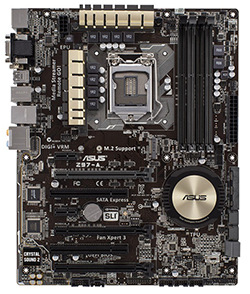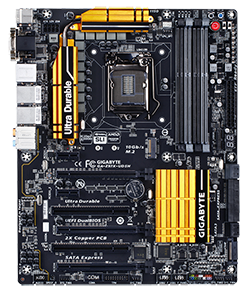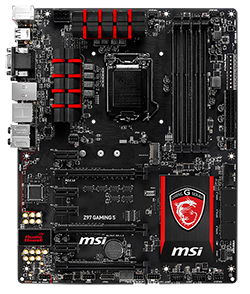Intel launched a bevy of Haswell Core processors last June. Presented in a LGA1150 form factor and therefore physically different to the LGA1155 Ivy Bridge processors of the year before, new chipsets were also launched to support these chips.
Haswell-supporting chipsets are numerous, catering for a wide range of markets. There's Z87, B85, Q87, Q85, H87 and H81, though Z87 remains the choice for the enthusiast. Usually paired with either the Core i5 4670K or 4770K, these boards are readily available from £65, and with the next generation Broadwell chip not ready for public consumption until the end of the year, there appears to be little to disrupt the status quo.
However, Intel and its motherboard partners are looking to reinvigorate the premium desktop space by launching a new chipset. This one's called Z97 and there have been plenty of leaks already.
Z97 is the logical replacement for incumbent Z87. Motherboard partners say it will literally substitute the older Z87 models from a price point of view. So why does Z97 exist, and what extra features does it bring?
The answer, surprisingly, isn't too much. Z97 follows Z87's blueprint almost to a tee. The only key differences, as far as we can tell - Intel has been very quiet on the technical front - is that Z97 has support for the M.2 SSD form factor, additional silicon resource on the chipset for SATA Express, and support for Devil's Canyon CPUs. Let's take each of these in turn.
M.2 SSDs
Formerly known as next-generation form factor (NGFF), M.2 is the replacement for the mSATA interface found on some motherboards. M.2 is interesting insofar as it can ride off either PCI Express or SATA 6Gbps, and this is why you see modern SSDs now available in this form factor. Intrepid motherboard manufacturers have already pinned M.2 on to a number of present-generation boards, while some SSD manufacturers have transplanted M.2 SSDs on to regular PCIe cards.
Intel's M.2 implementation on Z97 runs off PCI Express and uses two of the chipset's PCIe 2.0 lanes for storage duties, meaning a potential 1GB/s bandwidth on tap. Real-world transfer speeds, once overheads have been taken into account, are likely to be no more than 850MB/s, which is approximately 60 per cent more than offered by incumbent SATA 6Gbps.
But the use of just two lanes is somewhat surprising and disappointing given that, for example, the SandForce SF3700 SSD controller and Samsung XP941 M.2 SSD can use up to four lanes while, looking across to laptops, the 15in MacBook Pro also uses a four-lane PCIe topology for storage. Common sense indicates that Intel limits this because it merely runs out of usable PCIe lanes; the Z97 chipset, in sum, doesn't offer anything above the 24 present in Z87, of which 16 PCIe 3.0 are reserved for graphics stemming from the CPU.
SATA Express
Like M.2, SATA Express can use either the regular SATA interface or PCIe. The physical layer (PHY) is now integrated into the Z97 chipset and routed out to SATA Express-supporting ports. The obvious handicap to SATA Express adoption is the dearth of compatible drives - most drives remain SATA 6Gbps - so it's a case of building the storage infrastructure and then waiting on companies to launch compatible drives.
Asus, however, has already debuted SATA Express on select Z87 motherboards by teaming up with ASMedia. This time, working alongside Intel, Asus has implemented SATA Express on Z97 boards. Bridging from PCIe to SATA means some technical finagling is required, because PCIe's reference clock of 100MHz needs to be carried over, intimating additional expense from an implementation point of view. SATA Express gets around this obstacle by using a separate reference clock with independent spread-spectrum clocking (SRIS). This effectively means PCIe is 'clockless' as it relates to SATA Express.
Cutting to the chase, two-lane PCIe-based SATA Express offers a means by which to use next-generation SATA ports that promise increased speeds.
Devil's Canyon CPUs, plus extra protection
Intel is set to release faster-clocked versions of premium Haswell processors. Release date is unknown - they really should have debuted at the same time as this chipset - but promise higher overclocking potential through a revised thermal interface material. These chips will only work on 9-series boards, according to the chip giant, so Z97 will be the best bet for enthusiasts looking for a decent build in the summer of 2014.
Z97, then, is more of a features update than all-new chipset. There's also additional security by way of Intel Device Protection with Boot Guard. This business-class security is brought over to consumer chipsets for the first time, and it works through a combination of software and Haswell-architecture hardware to decrease the chances of malware and rootkits being installed on the machine.
Sage advice would suggest that anyone contemplating a Z87 board, unless massively reduced in price, would do well to wait a couple of days and see which Z97 boards fit into their budget. Speaking of boards, we have three in for review today, so click on below to see which one is right for you.
Intel Z97 Reviews |
||
















